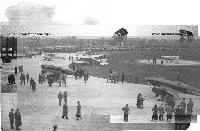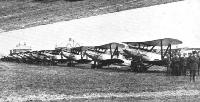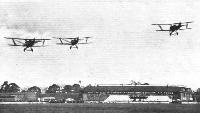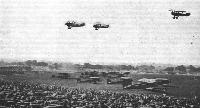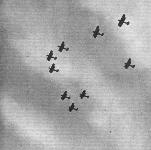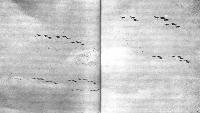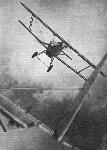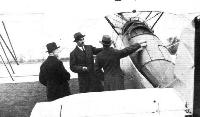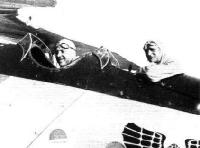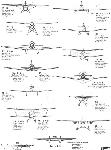
Варианты
- Fairey - Fox - 1925 - Великобритания
- Fairey - Fox IIIC/VIC - 1933 - Бельгия
Fox
Разведчик, легкий бомбардировщик и двухместный истребитель. Биплан с неубирающимся шасси. Создан в КБ фирмы "Фэйри авиэйшн".
Экипаж самолета - 2 чел.; двигатель и вооружение - в зависимости от модификации.
Первый полет опытный экземпляр "Фокса" совершил 3 января 1925 г.
Серийное производство развернули на заводе "Фэйри" в Хэйсе летом 1926 г., в апреле 1933 г. его перенесли на завод дочерней фирмы "Авионс Фэйри сосьете аноним бельж" в Госселье (Бельгия). Всего выпущено 230 экз. (с учебными вариантами).
Самолет состоял на вооружении в Великобритании с августа 1926 г., в Бельгии - с января 1932 г.
Выпускались следующие основные модификации:
- "Фокс" I с мотором D.12 или "Феликс", биплан смешанной конструкции с вооружением 2x7,69, бомбы до 240 кг; ближний разведчик;
- "Фокс" IA, аналог модели I с мотором "Кестрел" IIS;
- "Фокс" IIM, цельнометаллическая модификация для бельгийских ВВС, мотор "Кестрел" IIS, вооружение 2x7,69, бомбы до 200 кг; выпускался также учебный вариант "Фокс" IIS с мотором "Кестрел" IIS и двойным управлением;
- "Фокс" III, первая модификация бельгийской постройки, ближний разведчик с мотором "Кестрел" IIS и вооружением 3x7,62; в Великобритании выпускался также вариант "Фокс" IIIS с мотором "Кестрел" IIS и двойным управлением;
- "Фокс" IIIC, легкий бомбардировщик с закрытым фонарем кабины и бомбодержателями для крупных бомб под центропланом, мотор "Кестрел" IIS (на поздних сериях - "Кестрел" V, вооружение как у "Фокс" III, выпускался также вариант "Фокс" IIIC с двойным управлением;
- "Фокс" VI с мотором HS12Ydrs, выпускался в вариантах VIC - ближний разведчик с вооружением 3x7,62 и VIR - двухместный истребитель с вооружением 5x7,62 и другим радиооборудованием;
- "Фокс" VIII, модернизация типа VIR с вооружением 5x7,62 и трехлопастным винтом.
Производство "фоксов" прекратилось в мае 1939 г.
В Великобритании "Фокс" был снят с вооружения еще в первой половине 30-х годов, но в бельгийских ВВС все имевшиеся там модификации (начиная с IIM) сохранялись в боевых частях до начала Второй мировой войны. В сентябре 1939 г. - мае 1940 г. машины типов IIM и III были модернизированы с установкой закрытых фонарей кабин.
В мае 1940 г., когда немецкие войска напали на Бельгию, самолеты "Фокс" использовались как истребители (в т.ч. одноместные со снятым оборонительным вооружением), ближние разведчики и легкие дневные бомбардировщики. Значительная часть "фоксов" была уничтожена немецкой авиацией на земле. Уцелевшие машины вместе с прочими остатками бельгийской авиации эвакуировали во Францию, где их после капитуляции сдали немцам. Дальнейшая судьба этих самолетов неизвестна.
"Фокс" VI||
Размах:||11,56 м
Длина:||9,5 м
Моторы, количество х мощность:||1x875 л.с.
Взлетная масса, максимальная:||2245 кг
Максимальная скорость:||365 км/ч
Практический потолок:||11200 м
Дальность:||600 км
Описание:
- Fox
- Fairey Fox
- Flight, July 1928
THE FAIREY "FOX - Flight, June 1929
BRITISH AIRCRAFT AT OLYMPIA - Flight, November 1932
British Aircraft at the Paris Aero Show - Flight, November 1932
British Aircraft
Фотографии
-
Aeroplane Monthly 1994-02 / O.Thetford - Fox in service
Регистрационный номер: J7947 Fox I J7947 od 12 Sqn, early 1930
-
Aeroplane Monthly 1994-02 / O.Thetford - Fox in service
Регистрационный номер: J7950 [2] Fox I J7950 of 12 Sqn, 1928
-
Авиация и Космонавтика 2013-10 / В.Морозов - Великая воздушная гонка
Регистрационный номер: G-ACXO [4] Фэйри "Фокс" Р. Парера и Дж. Хеймсворта потерпел аварию уже в Ле-Бурже. До Новой Гвинеи его упорный экипаж добрался лишь через несколько месяцев
-
Авиация и Космонавтика 2013-10 / В.Морозов - Великая воздушная гонка
Регистрационный номер: G-ACXX [2], J8424 [2] Англичане Харольд Д. Гилмен и Джеймс К. Бейтс разбились на своем Фэйри "Фокс" в Южной Италии
-
Aeroplane Monthly 1994-02 / O.Thetford - Fox in service
Регистрационный номер: J7949 [3] Fox IA J7949 of 12 Sqn, late 1930
-
АвиаМастер 2003-04 / М.Жирохов - Они сражались за Фландрию. Бельгийские ВВС во второй мировой войне /Из истории воздушных войн/
Регистрационный номер: F1645 "Фокс-IIM" из эскадрильи "Мефисто", 1937г. Самолет в довоенной окраске.
-
Aeroplane Monthly 1993-12 / P.Jarrett - By day and by night: Fairey Fox (1)
The prototype Fairey Fox in its original form, with twin underwing radiators, at Hendon in February 1925.
-
Aeroplane Monthly 1993-12 / P.Jarrett - By day and by night: Fairey Fox (1)
THE FASTEST TWO-SEATER IN THE WORLD: The Fairey "Fox," fitted with Fairey "Felix" engine, shown in this photograph, is a high-performance two-seater day-bomber. Originally designed by the Fairey Aviation Co. as an entirely independent venture, the machine has now been ordered by the Air Ministry for the Royal Air Force, and is claimed to be the fastest two-seater in the world.
The first prototype Fairey Fox in its original form and unmarked. Its eight-minute maiden flight was made from Northolt on January 3, 1925. -
Aeroplane Monthly 1979-01 / I.Huntley - Fairey's elusive Fox
The prototype Fairey Fox in RAF livery but still without identity, possibly at the Andover display on July 29, 1925.
The Fox prototype during an early public appearance, now with roundels and rudder stripes. -
Aeroplane Monthly 1993-12 / P.Jarrett - By day and by night: Fairey Fox (1)
Регистрационный номер: J7941 [10] The first production Fox, J7941, at the Royal Aircraft Establishment, Farnborough, in 1926. The radiator is wound fully down.
-
Aeroplane Monthly 1979-01 / I.Huntley - Fairey's elusive Fox
Регистрационный номер: J7941 [10] The first production Fox I, J7941, with Capt Norman Macmillan lending scale to the 38ft span biplane in 1926. The aircraft was large for a single-bay machine, and tends to look deceptively small unless someone is posed by it.
-
Flight 1926-06 / Flight
Регистрационный номер: J7941 [10] R = KSV2:These three views of the Fairey "Fox," with Fairey "Felix" engine, give an excellent idea of Mr. Fairey's interpretation of the fundamental formula quoted at the beginning of this inscription. In the case of the "Fox," S is certainly small, K is probably very small, with the result that R is also small, and V quite perceptible.
-
Flight 1927-03 / Flight
Регистрационный номер: J7941 [10] Fairey "Fox" (Fairey "Felix"). The Fairey "Fox" - which, incidentally, is entirely of original design, evolved by the Fairey Aviation Co. independently of Air Ministry specifications - is a recent two-seater day bomber fitted with a Fairey "Felix" engine. It is, perhaps, one of the fastest machines of its type in the world, which is not surprising when one observes its exceptionally clean lines, and absence of all excrescences which might add head resistance - even the usual external Scarff gun ring has been eliminated. The "Fox" is now used by No. 12 (Bombing) Squadron, Andover.
-
Aeroplane Monthly 1993-12 / P.Jarrett - By day and by night: Fairey Fox (1)
Регистрационный номер: J7941 [10] The first production Fox being demonstrated at Northolt in June 1926. Note the camera port in the rear fuselage, just aft of the lower wing trailing edge.
-
Aeroplane Monthly 1979-01 / I.Huntley - Fairey's elusive Fox
Регистрационный номер: J7941 [10] "THROWING IT ABOUT": Captain Norman Macmillan making a nearly-vertical turn at low altitude on the Fairey "Fox."
Fairey chief test pilot Norman Macmillan demonstrates the first production Fox I, J7941, at Northolt in 1926. -
Aeroplane Monthly 1993-12 / P.Jarrett - By day and by night: Fairey Fox (1)
Регистрационный номер: J7941 [10] J7941, the first production Fox, being demonstrated for Flight’s photographer in June 1926.
-
Flight 1926-06 / Flight
Регистрационный номер: J7941 [10] THE FLYING FOX: Four views of the Fairey "Fox" in various aspects. The front view particularly illustrates the small frontal area of this machine. When these photographs were secured the "Fox" was piloted by Captain Norman Macmillan, the Fairey Chief Test Pilot.
-
Aeroplane Monthly 1994-01 / P.Jarrett - By day and by night: Fairey Fox (2)
Регистрационный номер: J7941 [10] The first production Fox, J7941, being demonstrated for Flight’s photographer at Northolt in June 1926. Note the lowered fuselage radiator.
-
Aeroplane Monthly 1982-11 / P.Capon - Capon's Corner
Регистрационный номер: J7948 [3] Another service visitor to Hamble, on March 9, 1927, was the Fairey Fox, J7948. This two-seat day bomber was powered by the 480 h.p. Curtiss D.12 Felix engine and had a top speed of 156 m.p.h. at sea level. One Vickers gun fired forward and a Lewis gun covered the tail. Normal bomb load was 460lb.
-
Aeroplane Monthly 1994-02 / O.Thetford - Fox in service
Регистрационный номер: J7948 [3] Fairey Fox I J7948, proudly displaying 12 Squadron’s new Fox’s head badge on its fin, prepares to taxy out at a Hendon RAF Display.
Felix-engined Fox J7948 with 12 Squadron in 1927. In spite of military fittings (note the radio generator panel below the rear cockpit), it still looks sleek. -
Aeroplane Monthly 1994-02 / O.Thetford - Fox in service
Регистрационный номер: J7948 [3] “Shiny Twelve” on parade with its Felix-engined Fox IAs at the Blackpool Air Pageant on July 7, 1928.
-
Aeroplane Monthly 1994-02 / O.Thetford - Fox in service
Felix-engined Fox J794? with the Special Duties Flight at Boscombe Down displays its unusual white cowling panels.
-
Aeroplane Monthly 1979-01 / I.Huntley - Fairey's elusive Fox
Регистрационный номер: J7950 [2], J7954 A pair of Fox Is of "Shiny Twelve", J7950 and J7954, with radiators lowered and the early unit marking on their fins.
-
Aeroplane Monthly 1994-02 / O.Thetford - Fox in service
Регистрационный номер: J7955 Fox I J7955 has the early 12 Sqn “12-in-a-ring” symbol on its fin.
-
Aeroplane Monthly 1976-06 / Personal album
Регистрационный номер: J7956 Fairey Fox I J7956, c/n F862, powered by a 480 h.p. Curtiss D-12 engine. The fin bears the numeral "12" - the only Squadron equipped with this superb two-seat day bomber. A fox’s head became 12 Squadron's emblem, and later adorned the rudder of their aircraft.
-
Aeroplane Monthly 1993-12 / P.Jarrett - By day and by night: Fairey Fox (1)
Регистрационный номер: J8427 Dual-control Fairey Fox J8427 was first flown on June 30, 1927. It spent much of its time with the RAE and A&AEE and its later life was spent on target-towing trials.
-
Aeroplane Monthly 1994-01 / P.Jarrett - By day and by night: Fairey Fox (2)
Exceptionally clean lines demonstrated by the Fox I.
-
Aeroplane Monthly 1994-02 / O.Thetford - Fox in service
Регистрационный номер: G-ACAS Fox I G-ACAS was awarded its C of A on March 23, 1933, and was operated by C. W.A Scott's Luxury Air Tours of Hanworth until it was burnt out on landing at Littlehampton, Sussex, on July 14 the same year.
-
Flight 1934-09 / Flight
Регистрационный номер: G-ACXO [4] No. 35: The Fairey "Fox" to be flown by R. Parer and G. E. Hemsworth.
-
Авиация и Космонавтика 2013-10 / В.Морозов - Великая воздушная гонка
Регистрационный номер: G-ACXO [4] Фэйри "Фокс" Р. Парера и Дж. Хеймсворта потерпел аварию уже в Ле-Бурже. До Новой Гвинеи его упорный экипаж добрался лишь через несколько месяцев
Fox I J7950 went on the civil register as G-ACXO, and is seen as entered for the 1934 MacRobertson England-Australia race. Note the filled-in upper centre-section trailing edge. -
Flight 1934-10 / Flight
Регистрационный номер: G-ACXO [4] Последние минуты перед стартом гонки на приз Мак-Робертсона
ON MACROBERTSON EVE: An impressive scene on the apron at Mildenhall. On the right stands Jones's and Waller's "Comet," with its undercarriage undergoing last-minute repairs; Baby Ruth is at the compass base; in the centre is the Mollisons' "Comet"; behind it are Hewett's and Kay's "Dragon Six" and a D.H. service "Dragon"; and in the background the "Gee-Bee" is being run up, while the ill-fated Fairey Fox can be discerned.Другие самолёты на фотографии: De Havilland Comet / D.H.88 - Великобритания - 1934De Havilland Dragon / D.H.84 - Великобритания - 1932De Havilland Dragon Rapide / Dominie / D.H.89 - Великобритания - 1934Gee Bee QED - США - 1934Monocoupe 90 / 110 / 145 - США - 1930
-
Aeroplane Monthly 1994-02 / O.Thetford - Fox in service
Регистрационный номер: G-ACXX [2], J8424 [2] The late New Zealand entry in the 1934 MacRobertson England-Australia air race, Fox IA G-ACXX, ex J8424, crashed and burned near Foggia, Italy, on October 22. Fg Off H.D. Gilman and J.K.C. Baines, its registered owner, lost their lives. The aircraft had been awarded its C of A on October 18, only two days before the start of the race.
-
Flight 1926-12 / Flight
THE FOX DAY-BOMBER: This photograph shows the clean lines and small frontal area of the Fairey "Fox." The suppression of all excrescences which might cause head resistance is particularly evident.
-
Flight 1928-08 / Flight
IN THE CAMP OF THE "ENEMY": "Fairey Foxes" of No. 12 Squadron warming up their engines at Andover, and, above, taking off in formation in the rain.
-
Flight 1928-07 / Flight
R.A.F. DISPLAY AT BLACKPOOL: The huge crowd that visited the Blackpool Air Pageant on July 7 were lucky witnesses of a splendid imitation of the R.A.F. Display at Hendon. This view shows the familiar Air Force machines which took part: Fairey "Foxes"
-
Flight 1927-07 / Flight
FOR EVENT NO. 1: A squadron of Fairey "Foxes" taxying out in readiness for the exhibition of air drill by three day bombing squadrons.
-
Aeroplane Monthly 1974-09 / ??? - Hendon Pageantry 1920-37
THE R.A.F. DISPLAY: Event No. 1. Air Drill by Day-bombing Squadrons. This was staged to show the improvement in performance of modern machines. In 2, a squadron of Fairey "Foxes" are seen taking off
Five Fairey Foxes from No. 12 Sqn take off at the 1927 pageant. -
Flight 1927-07 / Flight
THE R.A.F. DISPLAY: Event No. 1. Air Drill by Day-bombing Squadrons. This was staged to show the improvement in performance of modern machines. 3, shows a flight of Fairey "Foxes" approaching the enclosures in formation.
-
Flight 1928-07 / Flight
DISPLAY FEATURES: Fairey "Foxes" diving over the enclosures to demonstrate low bombing at speed.
-
Flight 1929-07 / Flight
DAY AND NIGHT: Three of the Fairey Fox Day Bombers, taking part in Event 9, fly over the Handley Page Hyderabad and Vickers Virginia Night Bombers waiting to take off in Event 10.
Другие самолёты на фотографии: Handley Page Hyderabad/H.P.24 / Hinaidi/H.P.33 / Clive/H.P.35 - Великобритания - 1923
-
Flight 1927-07 / Flight
THE R.A.F. DISPLAY: Bombing of the Village of "Hunyadi Janos in Irquestine." 1, shows the effect of the first bombs, dropped by Fairey "Foxes." In 2, after further attacks, the village is well alight
-
Flight 1929-07 / Flight
EVENT 9. LOW ATTACKS: A demonstration of low attacks was given by Day Bomber and Fighter Squadrons. Here are seen three Fairey Foxes of No. 12 Bomber Squadron.
-
Flight 1928-07 / Flight
AIR FORCE DISPLAY: Fairey "Foxes" at drill movements in formation. Each Squadron passed in succession from different directions performing similar drill orders.
-
Flight 1930-08 / Flight
No. 12 Bomber Squadron (Foxes) coming home to Andover from a raid.
-
Flight 1930-07 / Flight
54 Machines flying past: Three Fighter Squadrons on Siskins, one Bomber Squadron on Foxes, and two Bomber Squadrons on III F's.
Другие самолёты на фотографии: Armstrong Whitworth Siskin - Великобритания - 1921Fairey Fairey IIIF - Великобритания - 1926
-
Flight 1930-07 / Flight
EVOLUTION BY THREE DAY BOMBER SQUADRONS: Fairey Foxes in the lead, two Fairey III squadrons on the wings. The Foxes kept the better formation.
Другие самолёты на фотографии: Fairey Fairey IIIF - Великобритания - 1926
-
Flight 1928-08 / Flight
"Bombing-up": Aircraftsmen mounting one of the bombs on a Fairey "Fox."
-
Flight 1928-06 / Flight
3 января 1925г.: в аэропорту Хендон (Лондон) первый полет выполнил прототип скоростного дневного бомбардировщика Fairey Fox (пилот Норманн Макмиллан). На конструкцию самолета Fox большое влияние оказали гоночные гидросамолеты Curtiss.
FAIREY "FOX": Two-seater Bomber, with Rolls-Royce F.XI Engine. -
Aeroplane Monthly 1994-02 / O.Thetford - Fox in service
Регистрационный номер: J7943 RAF Display. This aircraft was converted from a Fox I after colliding with a Fairey IIIF while taxying on June 8, 1928. It was sold in June 1933, and might well have become the short-lived G-ACAS.
A Kestrel-engined Fox IA of B Flight, 12 Squadron, displaying the unit's fox's-head badge on its fin. -
Aeroplane Monthly 1994-02 / O.Thetford - Fox in service
Регистрационный номер: J7945 The view of 12 Sqn Fox 1A J7945 affords a good comparison of the distinctive nose outlines of the two variants.
-
Aeroplane Monthly 1994-02 / O.Thetford - Fox in service
Регистрационный номер: J7949 [3] Refuelling the Foxes of No. 12 B.S.
A trio of 12 Sqn Fox IAs later in their Service life, with a large “12” on their fuselage sides. -
Aeroplane Monthly 1993-12 / P.Jarrett - By day and by night: Fairey Fox (1)
Регистрационный номер: J9026 [7] The first Fairey Fox IA, J9026, at Martlesham Heath with dummy 230lb bombs for trials. Note the revised nose outline and different exhaust stubs of the Rolls-Royce F.XI installation.
-
Aeroplane Monthly 1994-01 / P.Jarrett - By day and by night: Fairey Fox (2)
Регистрационный номер: J9026 [7] Fox IA J9026 during trials at Martlesham Heath. This view is unusual in showing the rear-cockpit Lewis gun deployed.
-
Aeroplane Monthly 1994-01 / P.Jarrett - By day and by night: Fairey Fox (2)
Регистрационный номер: J9026 [7] В конце серийного производства Fox выпускался как Fox IА с мотором Kestrel IIA; J9026 - один из четырех Fox финальной производственной серии.
Fox IA J9026, powered by the Rolls-Royce F.XIIA engine, being flown by a pilot of 12 Squadron in April 1929.
Kestrel-engined Fox IA J9026 first flew on August 29, 1927, and was used for engine trials until January 1928. The Fox IA was distinguished from the D-12 (Felix) engined Mk I by the higher thrust-line, six exhaust stubs on each side instead of 12, and two struts protruding from the top of the undercarriage oleo leg instead of one. -
Aeroplane Monthly 1993-12 / P.Jarrett - By day and by night: Fairey Fox (1)
Регистрационный номер: J9026 [7] Fairey Fox IA J9026 was first flown on August 29, 1927 and was used mostly by the A&AEE as a trials aircraft.
-
Flight 1929-04 / Flight
Регистрационный номер: J9026 [7] THE LATEST VERSION: The Fairey "Fox," a High-performance single-engined Bomber, has been fitted with the Rolls-Royce F-type engine.
-
Aeroplane Monthly 1994-01 / P.Jarrett - By day and by night: Fairey Fox (2)
Регистрационный номер: J9026 [7] An air-to-air study of Fox IA J9026 taken in March 1929.
-
Aeroplane Monthly 1993-12 / P.Jarrett - By day and by night: Fairey Fox (1)
Регистрационный номер: J9026 [7] The first Fairey Fox IA, J9026, taking part in the RAF Pageant at Hendon on June 30, 1928.
-
Aeroplane Monthly 1994-01 / P.Jarrett - By day and by night: Fairey Fox (2)
Регистрационный номер: J9027 [2] Fox IA J9027 was used by the manufacturer for steam-cooling experiments, and is seen here with upper-wing surface condensers.
-
Aeroplane Monthly 1994-01 / P.Jarrett - By day and by night: Fairey Fox (2)
Регистрационный номер: J9027 [2] Another study of J9027 during steam-cooling experiments, this time without an underwing radiator and with a revised oil cooling system below the engine.
-
Flight 1930-10 / Flight
AS THE REAR GUNNER SEES IT: The Hawker Fleet Fighter with Rolls-Royce F.MS engine photographed from a Hawker "Hart." Mr. Bulman was piloting the "Hart," and the single setter was piloted by Mr. Sayer. Note that the two machines were making a turn, simulating a flight in which the two-seater is endeavouring to prevent the single-seater from getting "on its tail."
Другие самолёты на фотографии: Hawker Demon - Великобритания - 1932Hawker Hart - Великобритания - 1928
-
Моделист-Конструктор Ближние разведчики, корректировщики и штурмовики Второй мировой войны
"Фокс" IIM английского производства
-
Flight 1934-11 / Flight
VERSIONS OF THE FAIREY "FOX": The Hispano-engined model, which has a startling performance
-
Flight 1932-11 / Flight
FAIREY "FOXES" IN BELGIUM Machines lined up at Evere.
-
Flight 1932-01 / Flight
"BUY BRITISH": Three of the batch of Fairey "Fox" aircraft ordered by Belgium.
-
Flight 1932-09 / Flight
FAIREY "FOXES" AT EVERE AERODROME: In the Belgian Army the "Fox" is used as a reconnaissance aeroplane.
-
Air Pictorial 1977-10 / P.Bish, A.Clancy - Belgian Fairey Tale
Pleased with the Firefly, the Belgian A.F. selected the Fairey Fox for its day-bomber and reconnaissance squadrons and this type too was built under licence at Gosselies. Shown are some of the first Hayes-built Fox IIs for the Belgian A.F.
-
Flight 1932-08 / Flight
WINNER OF THE RACE FOR TWO-SEATER MILITARY AIRCRAFT: The Fairey "Fox" (Rolls-Royce "Kestrel") of the Belgian Air Force, which did the "Circuit of the Alps" at an average speed of 160 m.p.h.
-
Flight 1932-09 / Flight
PILOTS OF THE 5th GROUP, 1st REGIMENT D'AERONAUTIQUE, AT EVERE: Front Row (left to right), Adjudant De Groote, Capitaine Breulhez, Capitaine G. Verhaegen, Capitaine Vander Linden, Lieutenant Colonel Iserentant (Cdt. le Regiment), Major Hansenne (Commandant le Ve. Groupe), Adjudant Hoton, Ier Sergent Mouzon, Ier Sergent Baudoux. Back Row (left to right), Adjudant Crooy, Sous-Lieutenant Lenoir, Adjudant Forest, Adjudant Beerens, Adjudant Rombauts, Sergent de Vinck de Winnezeele, Ier Sergent Persenaire, Ier Sergent Dieu, Caporal Closset.
-
Flight 1935-04 / Flight
AN ELOQUENT ARRAY. A concentration of Fairey "Foxes" and "Fireflies" with Rolls-Royce "Kestrel IIS" engines at Everes Aerodrome, Belgium. The King of the Belgians has flown in one of the "Foxes."
Другие самолёты на фотографии: Fairey Firefly - Великобритания - 1925
-
Flight 1931-02 / Flight
Регистрационный номер: J9834 LE RENARD METALLIQUE: The Fairey all-metal "Fox" with Rolls-Royce F type engine is a high performance bomber. Its excellent qualities have received recognition recently in the form of substantial orders from the Belgian Government. The machines for Belgium will be almost identical with the British version shown here.
-
Flight 1932-01 / Flight
ONE OF BELGIUM'S NEW TWO-SEATERS: The Fairey "Fox" (Rolls-Royce "Kestrel") above the clouds, piloted by Mr. Andrew, one of Fairey's test pilots.
-
Aeroplane Monthly 1997-06 / Personal album. Military
This Gosselies-built Fox II has been adapted as a dual-control trainer for blind flying practice - note the folded hood at the bach of the rear cockpit.
-
Flight 1932-11 / Flight
THE FAIREY MACHINES: In this view the wings of the "Fox" rather hide the "Firefly," but actually on the stand both machines are readily viewed, which, needless to say, means admired.
Другие самолёты на фотографии: Fairey Firefly - Великобритания - 1925
-
Flight 1934-07 / Flight
A "FOX" IN CHINA: A Fairey "Fox" Mk. IV (R.R. Kestrel IIs) is being demonstrated in China. The authorities are very impressed by the machine and have indicated that it is far ahead of anything they have seen. The most prominent figure in the picture is Colonel Wu, of the Kwangsi Air Force, who shot down a Japanese aircraft during the Sino-Japanese troubles at Shanghai. Colonel Wu has flown the "Fox."
-
Flight 1934-10 / Flight
BRER FOX, HE FLY HIGH: A group of interested spectators round the Fairey "Fox," which gave demonstrations at Shanghai.
-
Flight 1935-07 / Flight
REGAL ENTHUSIASM. H.M. the King of the Belgians attended the recent display of the Belgian Air Force at Evere. He is seen with Queen Astrid after alighting from the Fairey "Fox" in which he had flown.
-
Flight 1932-02 / Flight
Mr. Macpherson is seen explaining the features of the Fairey "Fox" to Col. Tetu and M. Caquot.
-
Flight 1934-11 / Flight
VERSIONS OF THE FAIREY "FOX": The Advanced Training Type, fitted with Siddeley "Serval" engine.
-
Flight 1932-08 / Flight
THE PILOT OF THE "FOX": Capt. Van der Linden, of the Belgian Air Force, and His Passenger.
-
Aeroplane Monthly 1993-12 / P.Jarrett - By day and by night: Fairey Fox (1)
Регистрационный номер: J7957 KEITH WOODCOCK’S painting depicts Curtiss-engined Fox I J7957.
-
Aeroplane Monthly 1994-01 / P.Jarrett - By day and by night: Fairey Fox (2)
Регистрационный номер: J7949 [3] KEITH WOODCOCK’S painting depicts 12 Sqn Fairey Fox 1A J7949 over a Vickers Mk II medium tank on Salisbury Plain.
-
Aeroplane Monthly 1993-12 / P.Jarrett - By day and by night: Fairey Fox (1)
Регистрационный номер: J7941 [10] -
Aeroplane Monthly 1992-01
First flight of the Fairey Fox: January 3, 1925
-
Aeroplane Monthly 1990-10 / C.Hall - Rich Mixture
... a red flag could be flown
-
Flight 1934-10 / Flight
Другие самолёты на фотографии: Bellanca 28 Flash - США - 1934De Havilland Comet / D.H.88 - Великобритания - 1934De Havilland Fox Moth / D.H.83 - Великобритания - 1932De Havilland Leopard Moth / D.H.85 - Великобритания - 1933Harkness & Hillier All Australian - Австралия - 1934Lockheed Sirius / Altair 8 - США - 1929Lockheed Vega - США - 1927Miles Falcon M.3 / Hawcon M.6 - Великобритания - 1934Monocoupe 90 / 110 / 145 - США - 1930Northrop Delta - США - 1933Percival Gull - Великобритания - 1932Short Scion / S.16 - Великобритания - 1933
-
Aeroplane Monthly 1994-02 / O.Thetford - Fox in service
12 Sqn was the only RAF squadron to be equipped with the Fairey Fox
-
Flight 1929-07 / Flight
Fairey "Fox" Rolls-Royce F XI Engine
-
Aeroplane Monthly 1979-01 / I.Huntley - Fairey's elusive Fox
Fairey Fox Mk 1
- Фотографии






























